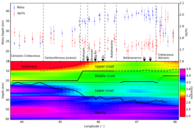Lithosphere structure in Madagascar: Implications for the geodynamic processes that have shaped Madagascar

Georg Foster-Research Fellowship (HERMES), Alexander von Humboldt
The assembly and separation of supercontinents during the Wilson cycle (during which a continents rift and later converge, reassembling the fragments) are key geological processes to understand the long-term plate tectonic evolution of the Earth's surface. Madagascar is an ideal place to study the multistage assembly and break up of Gondwanaland, the supercontinent whose break-up also gave rise to many present-day continental regions (South America, Africa, Antarctica, Australia, Arabia and India). The surface traces of assembly and breakup processes have been studied extensively using geological methods in Madagascar and elsewhere, but the imprint on the deep structure has so far not been studied in much detail because of the relative sparsity of seismological studies in Madagascar. In this project we aim to determine the detailed Earth structure associated with the different geological domains of Madagascar based on new temporary seismic experiments that were carried out in Madagascar between 2011 and 2014. The results will not only shed light on the geodynamic processes that have shaped Madagascar, including more recent modifications to the lithospheric fabric, but will also have practical implications for improving knowledge of the seismotectonics.


